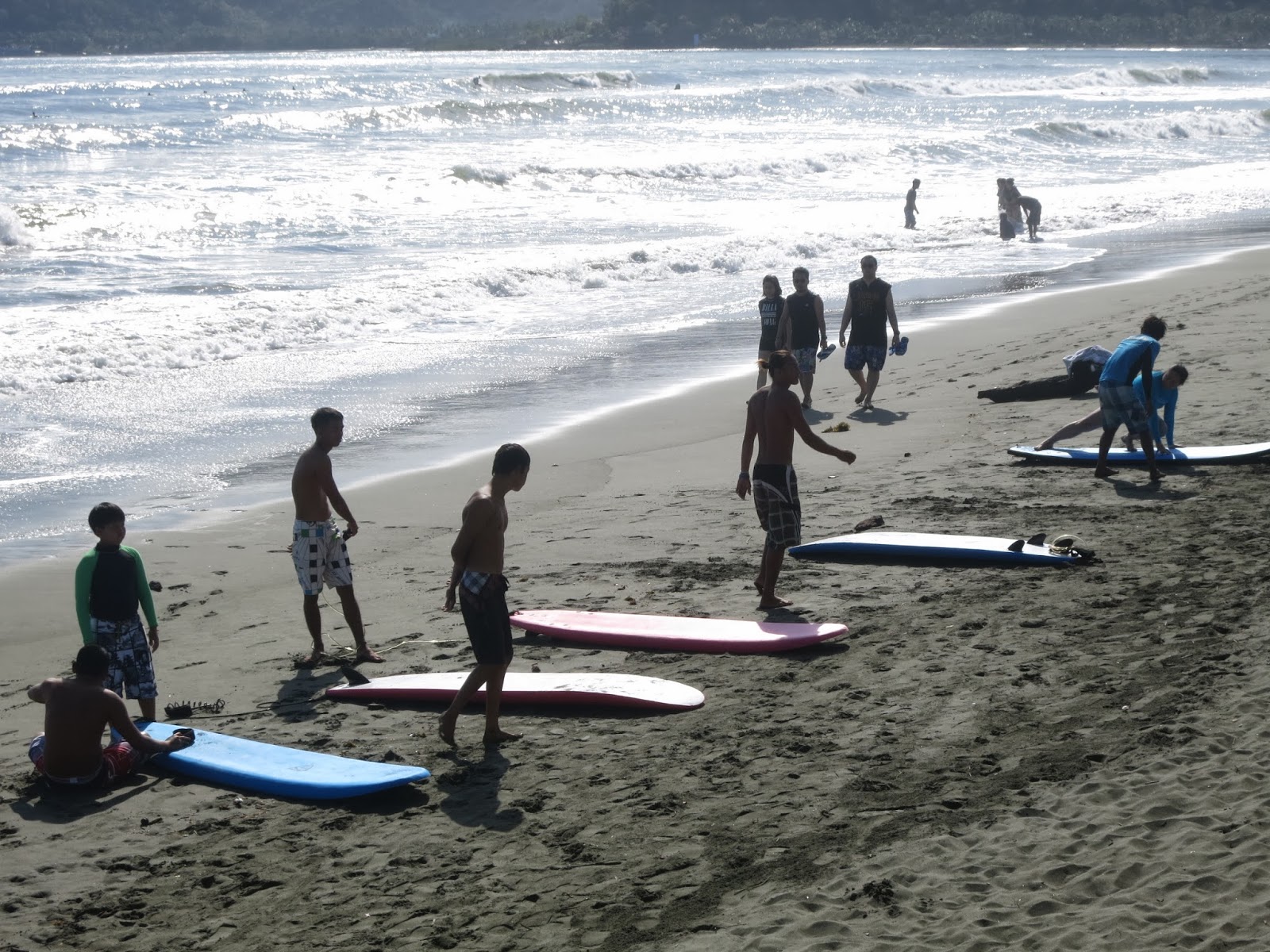It goes something like this - in the 70s, Francis Ford Coppola's movie "Apocalypse Now" was shot in Baler. After the shoot, the movie crew left behind surfboards and the locals taught themselves on how to surf. Today, it's not just Filipinos who go to Baler to surf but surfers all over the world. It's amazing how one movie (without any deliberate intention) changed the fate of one simple and quiet town.
Over the weekend, we visited Baler. It's about 4.5 hours drive from Pampanga (maybe about 5 hours from Manila).
The drive to Baler is very scenic. You'll see landscapes like these -
We stayed at the Costa Pacifica Resort. Here's the view from the main lobby.
And here's our room -
What's nice about the rooms is that windows are floor to ceiling and you get to enjoy a good view. Here's the view from our room.
The interior of the resort is beautifully-designed. Check out a waiting nook at the lobby -
The food at Costa Pacifica is good. Breakfast is buffet. Yay! The resort offers lunch and dinner buffet too but it's a bit pricey at Php888 (if I remember right). But you can always order ala carte if buffet is too much for you.
Here's the boardwalk.
In the morning, the beach is teeming with surfers. This was about 8am on a Saturday morning.
Since I don't surf and don't have the guts to try it out, I was contented just watching the surfers. :)
In exploring Baler, you could hire a tour guide. I'm not sure if the rates across Baler are standard but the tour guide we arranged at the hotel costs Php1,500 (assuming you have your own transportation). If you don't have a vehicle, they offer van rental for Php2,000 (half-day).
The tour usually lasts 3 to 4 hours. But in our case since we started way past noon, we weren't able to visit all the places in the standard itinerary. Here are the places we visited:
1. Dicasalarin Cove. This is the personal property of Senator Ed Angara but they allow tourists to visit. There's an entrance fee of Php100.
I've heard people say that Baler reminds them of Hawaii and when I saw this spot at Dicasalarin, it did remind me of Hawaii. Breathtaking view. That's Pacific Ocean right there.
According to our tour guide, this is where Sen. Ed Angara stays when in Baler.
There are 4 cabin-like accommodations connected to a gazebo.
Here's the view at the Dicasalarin beachfront.
And that tiny white thing on top of the rock formation is the Dicasalarin lighthouse.
Within the Dicasalarin premises, there are also sabutan trees.
Here are close up shots of the sabutan leaves. The tour guide said its fruits, which look like orange pineapples, are poisonous.
For those not familiar with sabutan, the leaves are made into straws and dyed like these.
And then they are woven into bags, slippers and wallets like these -
They are also made into gowns and occasionally worn by beauty pageant contestants.
2. Ermita Hill. This is the place where you'll find the statues below. This commemorates the tsunami survivors of Baler in 1735. The survivors who come from seven different families swam towards the Ermita Hill which saved their lives.
3. Museo de Baler. Fronting the museum is a statue of Pres. Manuel Quezon who's from Baler.
Within the grounds, there's also a replica of the house where Pres. Quezon was born and raised.
Inside the museum, you'll find artifacts, artworks and also memorabilia from the movie "Baler".
 |
| Costume worn by Anne Curtis in the movie "Baler". |
 |
| Costume worn by Jericho Rosales in the movie "Baler". |
 |
| Preserved Philippine Eagle |
Here's inside the house.
5. Baler Church. Right across Dona Aurora's house is the Baler Church.
Once upon a time, this church served as a garrison for renegade Spanish soldiers. This group of soldiers only surrendered to the Americans after one year of American occupation. Because of this, this is considered the last Spanish stronghold in the Philippines and also known as "Siege of Baler".
That's all we saw around Baler. I think the spots we missed to visit due to lack of time were the Balete Tree and Mother Falls which were a bit far.
Here are other tips:
For food, we also tried Bay's Inn - just adjacent to Costa Pacifica.
We tried several dishes but their bestseller according to their waiters (as well as from online articles) is the Garlic Chicken. Yum.
As we were planning where to eat next, we checked the menu of the adjacent Baler View Inn and found out that most of the items we ordered at Bay's Inn were available there too. Their garlic chicken might be worth checking out too.
In the morning, there are vendors who peddle Suman. The suman is wrapped in sabutan leaves. I like Baler's suman because it's not too sweet. The suman costs about Php5 per piece. The breakfast buffet in Costa Pacifica has suman too and they have chocolate flavored suman. Yum.
For pasalubong, you can go to the Pasalubong Center located near the market (palengke). This is where you can buy sabutan-made products, souvenirs and food items.
Another popular product of Baler is Nanay Pacing's homemade peanut butter and coco jam. There's a sales outlet just a few minutes away from the Pasalubong Center. Each bottle costs Php150.
If you like vinegar (like I do), you can also buy a bottle of Sukang Tuba.












































